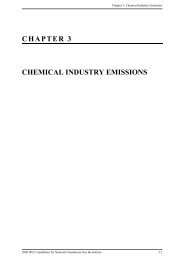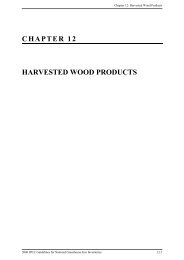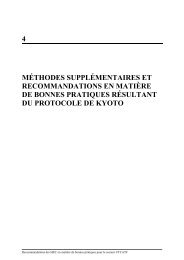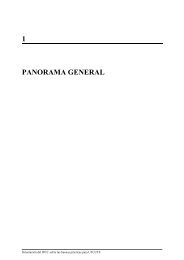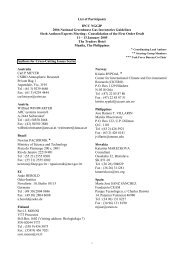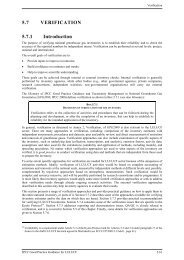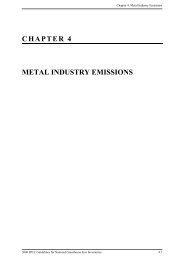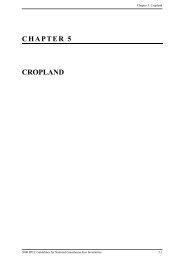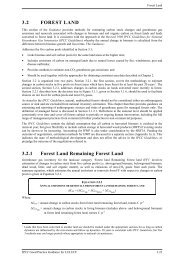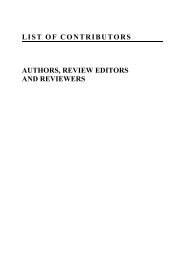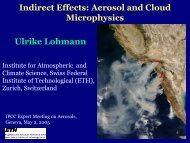Use of Models and Facility-Level Data in Greenhouse Gas Inventories
Use of Models and Facility-Level Data in Greenhouse Gas Inventories
Use of Models and Facility-Level Data in Greenhouse Gas Inventories
Create successful ePaper yourself
Turn your PDF publications into a flip-book with our unique Google optimized e-Paper software.
<strong>Use</strong> <strong>of</strong> <strong>Models</strong> <strong>and</strong> <strong>Facility</strong>-<strong>Level</strong> <strong>Data</strong> <strong>in</strong> <strong>Greenhouse</strong> <strong>Gas</strong> <strong>Inventories</strong><br />
modell<strong>in</strong>g monthly growth <strong>and</strong> production through out the year, <strong>and</strong> then determ<strong>in</strong><strong>in</strong>g the energy requirements over this<br />
smaller time <strong>in</strong>terval, a more accurate picture <strong>of</strong> the emissions produced from livestock can be obta<strong>in</strong>ed.<br />
Changes <strong>in</strong> the natural environment throughout the year can be <strong>in</strong>corporated <strong>in</strong>to the calculations. This is more<br />
important <strong>in</strong> pasture feed situations where the quality <strong>of</strong> feed changes through out the year. For example, currently<br />
monthly estimates <strong>of</strong> feed energy concentration, digestibility <strong>and</strong> nitrogen content are factored <strong>in</strong>to the calculations.<br />
These values are based on historic pasture samples taken through out the year, but there is currently limited <strong>in</strong>formation<br />
on how this may change from year to year. Research is cont<strong>in</strong>u<strong>in</strong>g <strong>in</strong> this area <strong>and</strong> <strong>in</strong> the future it will be possible to<br />
<strong>in</strong>clude actual real time measurements <strong>of</strong> these three variables from satellite imagery. This will allow measurements <strong>of</strong><br />
feed quality on a monthly basis, at a regional level <strong>and</strong> can <strong>in</strong>corporate changes from year to year. Development <strong>of</strong> this<br />
improvement has been more problematic than it may be <strong>in</strong> other countries due to the large amount <strong>of</strong> cloud cover over<br />
New Zeal<strong>and</strong> at certa<strong>in</strong> times. This has restricted the speed at which verification <strong>of</strong> a relationship between the imagery<br />
<strong>and</strong> actual pasture measurements has been able to occur.<br />
In the latest Inventory the model was further developed to estimate dairy emissions on a regional basis us<strong>in</strong>g regional<br />
productivity data. Therefore the differences <strong>in</strong> dairy productivity among regions can now be used to improve the<br />
accuracy <strong>of</strong> the model. This was achievable through very concise dairy productivity data dat<strong>in</strong>g back to 1990. The<br />
population model for dairy can now be improved so that regional differences can be <strong>in</strong>corporated. For example calv<strong>in</strong>g<br />
date, milk production curves etc. The differences <strong>in</strong> feed quality among regions will also be able to be <strong>in</strong>corporated once<br />
available, further improv<strong>in</strong>g the calculations.<br />
Comparability<br />
Us<strong>in</strong>g a model to calculate emissions from New Zeal<strong>and</strong> agriculture means that emissions can be determ<strong>in</strong>ed for a<br />
calendar year. Population data fed <strong>in</strong>to the model is a snap shot <strong>of</strong> the population at one po<strong>in</strong>t <strong>in</strong> time <strong>in</strong> the year. This<br />
po<strong>in</strong>t <strong>in</strong> time is the end <strong>of</strong> June, which the end <strong>of</strong> the f<strong>in</strong>ancial year for many farm<strong>in</strong>g bus<strong>in</strong>ess’s but is the middle <strong>of</strong> the<br />
calendar year. By us<strong>in</strong>g this <strong>in</strong>formation <strong>and</strong> estimat<strong>in</strong>g populations on a monthly basis, the months can then be<br />
aggregated <strong>in</strong>to a calendar year. This results <strong>in</strong> an Inventory which is comparable with other countries.<br />
Validation, documentation <strong>and</strong> transparency.<br />
It is important that the models used <strong>in</strong> the calculation <strong>of</strong> emissions from livestock are transparent so that they are easily<br />
validated <strong>and</strong> reviewable. With further disaggregation <strong>of</strong> data <strong>and</strong> categories <strong>and</strong> changes to methodologies that require<br />
<strong>in</strong>creas<strong>in</strong>g amounts <strong>of</strong> activity data, produc<strong>in</strong>g consistent time series may become more difficult as the methodology<br />
moves away from the current pool <strong>of</strong> exist<strong>in</strong>g data dat<strong>in</strong>g back to 1990. Methods <strong>of</strong> extrapolat<strong>in</strong>g data <strong>in</strong> the IPCC<br />
guidel<strong>in</strong>es will need to be implemented, <strong>in</strong>clud<strong>in</strong>g expert judgment <strong>and</strong> predict<strong>in</strong>g data from exist<strong>in</strong>g <strong>in</strong>formation.<br />
Validation<br />
As agriculture is such a large component <strong>of</strong> the New Zeal<strong>and</strong> Inventory, research <strong>in</strong> this area is ongo<strong>in</strong>g <strong>and</strong> extensive.<br />
Results are cont<strong>in</strong>ually fed <strong>in</strong>to the model <strong>in</strong> order to improve model outputs. This <strong>in</strong>cludes further research <strong>in</strong><br />
calorimeters to improve the estimation <strong>of</strong> methane emission from different livestock categories. The orig<strong>in</strong>al<br />
development <strong>of</strong> the model was based on extensive livestock emission research which is peer reviewed <strong>and</strong> published <strong>in</strong><br />
scientific journals. The <strong>in</strong>corporation <strong>of</strong> new research <strong>in</strong>to the model also requires <strong>in</strong>ternational peer reviews. Suggested<br />
changes are presented to an expert advisory panel which assesses the robustness <strong>of</strong> the science <strong>and</strong> any reviewers<br />
concerns before any decision for <strong>in</strong>clusion is made. The extensive scientific research required <strong>and</strong> <strong>in</strong>ternational peer<br />
reviews required aid <strong>in</strong> the validation <strong>of</strong> the model outputs. Because the <strong>in</strong>ventory model is based along the same l<strong>in</strong>es<br />
as the tier 2 equations suggested <strong>in</strong> the IPCC guidel<strong>in</strong>es, implied emission factors derived from the model outputs are<br />
easily comparable with other counties.<br />
Documentation<br />
All the equations <strong>and</strong> methodologies used with<strong>in</strong> the Inventory model are documented so that calculations can be carried<br />
out external to the model if required. The document can be validated aga<strong>in</strong>st the equations <strong>and</strong> code with<strong>in</strong> the model<br />
itself, <strong>and</strong> the comparison <strong>of</strong> outputs from the external calculations <strong>and</strong> model calculations can also aid <strong>in</strong> the validation<br />
<strong>of</strong> results. Cont<strong>in</strong>ual improvements <strong>in</strong> this area will aid <strong>in</strong> the ease <strong>of</strong> this validation.<br />
Transparency<br />
Although the calculations with<strong>in</strong> the model can be complex due to the monthly time step, all equations, cod<strong>in</strong>g used,<br />
<strong>in</strong>put <strong>and</strong> output worksheets can be accessed. For example the population model produces excel worksheets with<br />
IPCC Expert Meet<strong>in</strong>g Report 50 TFI




